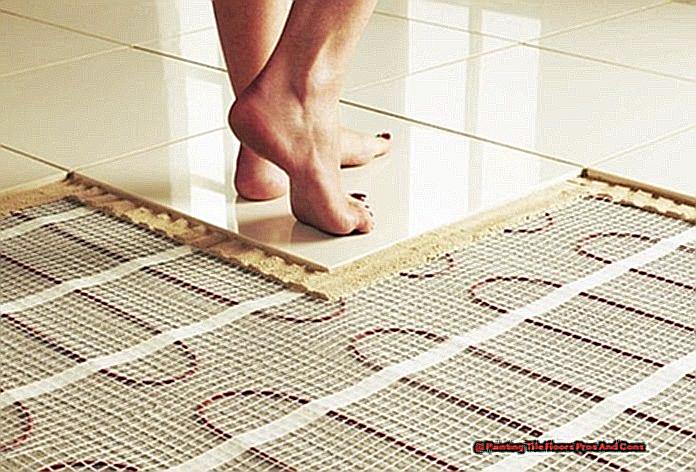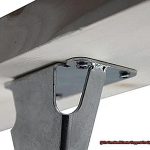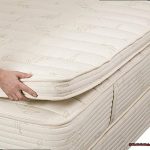Are you tired of staring at the same old tile floors in your home? Do you want to give them a fresh new look without breaking the bank? Well, painting your tile floors might just be the answer. It’s a budget-friendly and relatively easy way to update the look of your space. But before you grab that paintbrush, let’s take a closer look at the pros and cons of this DIY project.
Pros:
- A cost-effective alternative to replacing tiles
- A wide range of color options available for a personalized touch
- Can easily cover up stains or damage on existing tiles
- Adds a unique and modern flair to any room
Cons:
- Requires proper preparation and maintenance for long-lasting results
- Not suitable for high traffic areas or rooms with moisture issues
- May not be as durable as traditional tiled floors
- Can be time-consuming, especially for larger areas
Now that we’ve laid out both sides of the argument, it’s up to you to decide if painting your tile floors is worth it. Just remember, consulting with a professional or doing thorough research beforehand can help ensure successful results.
Contents
Painting Tile Floor Pros and Cons
Painting tile floors has numerous benefits such as being cost-effective, easy and quick to apply, customizable, durable, and easy to maintain. However, there are also drawbacks to consider such as limited lifespan, the necessity for proper preparation, unsuitability for certain types of tiles, limited repair options, and design limitations in high-traffic areas. Ultimately, deciding whether to paint your tile floors should be based on your personal preferences, budget, and the type of tiles you have.
While painting tile floors can save you money compared to installing new flooring, it is important to properly prepare the surface beforehand. This includes cleaning and sanding the tiles to ensure proper adhesion of the paint. Failure to do so can result in a less than desirable outcome and may require costly repairs or replacements in the future.
Although painting allows for customization and a variety of design options, it is important to note that not all types of tiles are suitable for this method. Tiles with a glossy finish or those made of natural stone may not hold paint well and may require additional preparation or special paints.
Furthermore, painted tile floors may not last as long as their original counterparts and may require touch-ups or repainting in high-traffic areas. However, with proper maintenance and care, they can still provide a durable and cost-effective flooring option.
In conclusion, painting tile floors has both pros and cons that must be carefully considered before making a decision. It is important to weigh the benefits against potential drawbacks and choose the best option for your personal needs and circumstances.
When Should You Paint Your Floor?
The decision to paint your tile floors is not one to be taken lightly. There are a multitude of factors that need to be carefully considered in order to achieve a successful and long-lasting paint job. From the condition of the tiles to the type of paint, from the desired color and design to the amount of foot traffic, each aspect plays a crucial role in determining when is the best time to embark on this project.
First and foremost, it is important to evaluate the condition of your tiles. Are they chipped, cracked, or stained? If so, painting may be a viable solution to give them a new lease on life. Next, consider the type of paint you will be using. Will it be suitable for your particular floor type? Will it provide adequate durability against foot traffic? These are all essential questions to ask before making any decisions.
Furthermore, think about the amount of foot traffic in the area where you plan on painting. If it is a high-traffic area, then you will want to choose a paint that can withstand wear and tear. Additionally, consider the color and design you desire for your space. This will not only affect the type of paint you choose but also the overall aesthetic appeal of your floor.
The time of year is also a crucial factor in determining when to paint your tile floors. Ideally, you want to avoid painting during times of high humidity or extreme temperature fluctuations. This can affect the drying process and ultimately impact the quality of your paint job.
Additionally, proper preparation is key to achieving a successful outcome. Make sure to thoroughly clean and prime your tile floors before painting. This will ensure that the paint adheres properly and lasts longer.
Last but certainly not least, consider your budget when making this decision. While painting your tile floors can be a cost-effective alternative to replacing them entirely, it is still important to consider the cost of materials and labor.
In conclusion, painting your tile floors requires careful consideration of various factors such as tile condition, type of paint, foot traffic, desired color and design, time of year, preparation process, and budget. By thoroughly assessing each aspect, you can ensure a successful and long-lasting paint job for your tile floors. So next time you ask yourself, “When should I paint my floor?”
How to Paint your Tile Floor
Painting your tile floor may be the perfect solution for you. With a few simple steps, you can completely transform the look of your floor and customize it to your liking. Let’s dive into the process of painting your tile floor and explore the pros and cons of this cost-effective method.
Firstly, before you begin, it is crucial to properly clean and prepare your tile floor. This will ensure that the paint adheres properly and gives you a smooth finish. Next, sanding the surface will help to remove any imperfections and create a better surface for the primer to stick to. Speaking of primer, this is an essential step in the process as it will provide a base for the paint and prevent any stains or discoloration from showing through.
Now, onto the fun part: painting your tile floor. The best part about this method is that you have complete control over the color and design of your floor. You can choose a solid color or even get creative with patterns and designs. Once the paint is dry, sealing your tile floor is crucial to protect it from wear and tear and make it more durable.
One of the main advantages of painting your tile floor is its cost-effectiveness. It’s a budget-friendly option compared to replacing your entire floor. Plus, with so many customization options, you can truly make your floor unique and personalized. Not to mention, painted tile floors are surprisingly durable and can withstand heavy foot traffic.
However, there are some downsides to consider as well. Proper preparation is crucial for a successful outcome, so be prepared to put in some time and effort before you start painting. Additionally, in high moisture areas like bathrooms or kitchens, painted tile floors may not hold up as well as other flooring options. There is also the risk of creating a slippery surface, so be cautious when walking on a painted tile floor.
So, painting your tile floor is a great way to give your room a fresh new look without breaking the bank. With proper preparation and maintenance, it can be a durable and cost-effective option for your home. However, be aware of its limitations and make sure it is the right choice for your specific needs.
Conclusion
In summary, painting tile floors can be a cost-effective and simple solution for revamping your living space.
With a vast array of color options available, it offers the opportunity to cover up any unsightly stains or damage on existing tiles. However, it’s important to note that proper preparation and maintenance are crucial for achieving long-lasting results.
Additionally, painting may not be suitable for areas with high foot traffic or moisture issues. Ultimately, the decision to paint your tile floors should be carefully considered, taking into account factors such as tile condition, paint type, foot traffic levels, desired aesthetic, time of year, preparation process, and budget constraints.
By approaching this project with the right mindset and strategy, you can give your home a unique and contemporary touch without breaking the bank.





